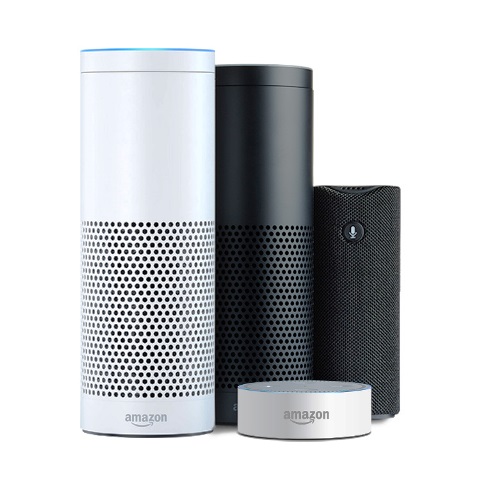
Image source: Amazon
Out of all the gadgets displayed at the Consumer Electronics Show (CES) last week, smart speakers like Google Assistant and Amazon Alexa drew the most interest. Commentators advise marketers to hear the message: Smart speakers and other connected, voice-controlled devices hold enormous opportunities and implications for marketing.
AI-powered smart speakers that accept voice commands open the door to building audio-based marketing. “This trend is becoming more mainstream and it allows for brands to determine their sonic identity and really use AI to have a much more scalable presence there,” Pandora CMO Aimée Lapic told AdWeek at the CES. While consumers embrace voice search and connected devices, marketers generally remain focused on visual branding.
Technology and consumer appliance firms at the CES announced partnerships with smart speaker producers, Business Insider reports. Smart home camera company Canary is adding Alexa video support to its systems. Whirlpool is building more support for voice assistants into its appliances. Dishwasher, refrigerators and other appliances can be controlled remotely by voice. Accessory company D-Link announced home security cameras that can integrate with Alexa and Google Assistant.
Ownership of smart speakers has exploded in the last few years. One-in-six Americans (16%) own a voice-activated smart speaker, up 128% from January 2017, according to the Smart Audio Report from Edison Research. Consumers first used the speakers to listen to music, and then soon started voice search and completing household task. Most importantly for marketers, people have started shopping with the smart speakers. More than half (57 percent) of smart speaker owners have used the devices to complete a purchase.
Smart Recommendations for Marketers
Tom Webster, vice president strategy for Edison Research, offers these recommendations for marketers:
In your marketing messages, be clear with consumers about what you want them to say and what you want them to do to access your brands through smart speakers. For example, if you tell Alexa to “Play lite FM,” it won’t necessarily play lite FM in New York — it may play a lite FM station in Beirut.
Consider creating or sponsoring audio content such as ads and podcasts designed to be listened to by families or groups in parties and other social settings. After a decade of earbud listening, smart speakers encourage a trend back to listening in groups.
Strive to remove friction in the purchasing process. Smart speakers remove obstacles to purchasing products. Brands that follow Amazon’s example and sell products with the fewest steps possible will gain the competitive advantage.
Because most owners use smart speakers for voice searches, the devices will greatly increase the importance of voice search optimization and audio content marketing.
Isabelle Wattenberg at MSP Communications recommends these steps:
Research. Find if your audience uses the devices, if demographics of purchasers align with your target audience, ask what questions and pain points your audience has and what smart speaker integrations they use most frequently.
Voice optimization. Optimize content so smart speakers can find it. FAQs, local content and articles optimized for longtail keywords are best. Most people use questions to search through smart speakers. Find out the most common questions buyers ask about your product category and incorporate those questions into your online promotional materials.
Audio ads. With 68 percent of users listening to music on the speakers, ads on Pandora or Spotify could be effective.
Podcasts. Consider if your company has a thought-leader or unique approach to a topic that could be packaged as a podcast. One new content form gaining traction is the “Flash Briefing”—a brief audio segment that rounds up the news of the day or news about a specific topic, such as AARP’s flash briefing.
Bottom Line: Smart speakers and other voice-activated connected technologies bring enormous opportunities for marketers. Consumers love the devices; sales have increased rapidly. More people are searching the web with the devices rather than their smartphones. In response, more brands are pursuing audio-based marketing strategies.
William J. Comcowich founded and served as CEO of CyberAlert LLC, the predecessor of Glean.info. He is currently serving as Interim CEO and member of the Board of Directors. Glean.info provides customized media monitoring, media measurement and analytics solutions across all types of traditional and social media.




